Analysis of Pitching and Negotiation Skills at Marks and Spencer
VerifiedAdded on 2020/12/18
|13
|3541
|107
Report
AI Summary
This report examines negotiation and pitching skills within the context of Marks & Spencer (M&S). It begins by defining negotiation, its importance, and key stakeholders, followed by an analysis of the negotiation process, including preparation, opening, bargaining, and closure phases. The report then delves into the Request for Proposal (RFP) process, outlining required documentation and the contractual process, with an application to M&S. It evaluates tendering and contract processes, offering recommendations. Furthermore, the report explores pitch development, emphasizing key principles for a competitive edge and evaluates pitching at M&S. Finally, it addresses potential pitch outcomes, organizational obligations, and risk management, concluding with a comprehensive overview of negotiation, pitching, and their implications for business operations.

Pitching and Negotiation
Skills
Skills
Paraphrase This Document
Need a fresh take? Get an instant paraphrase of this document with our AI Paraphraser
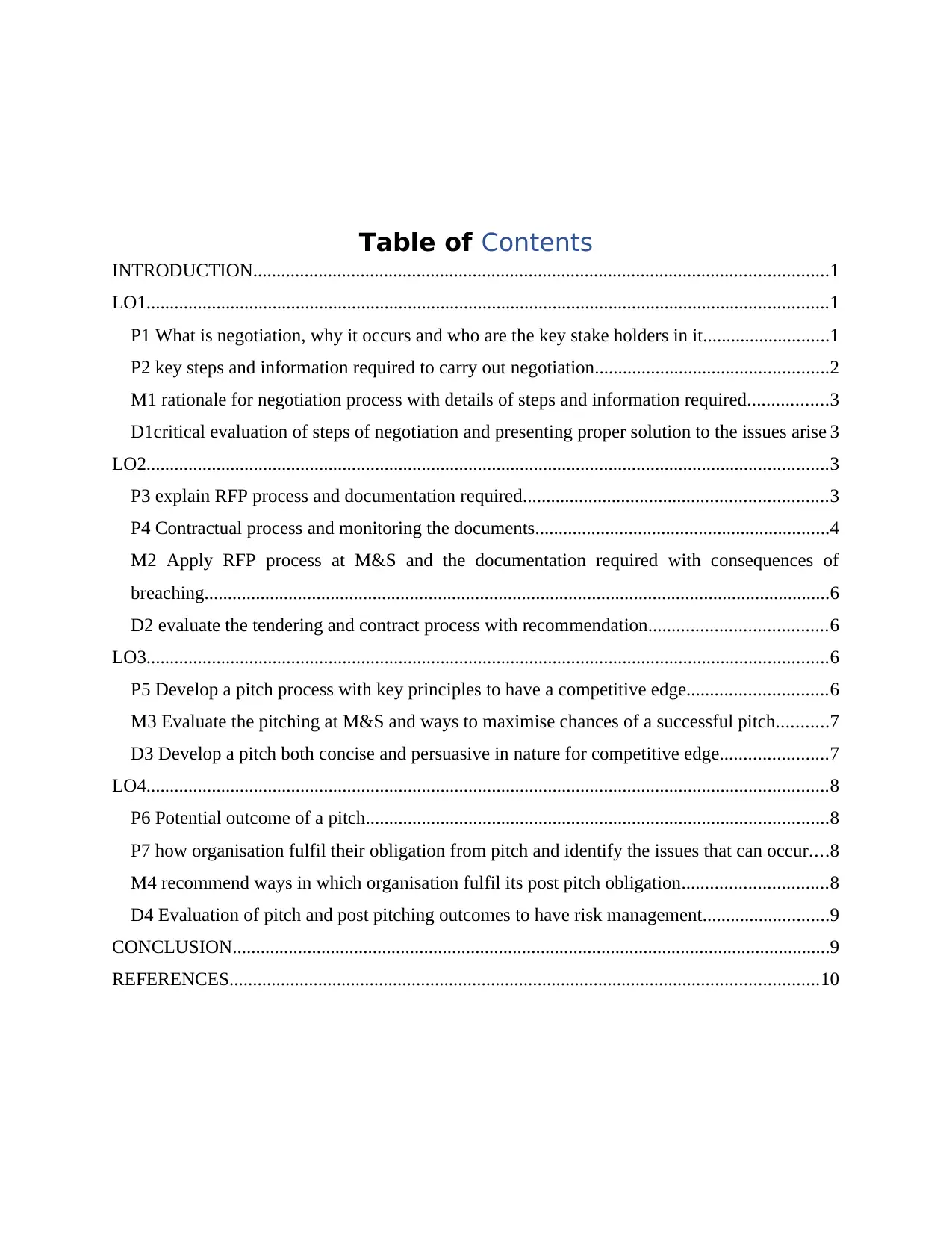
Table of Contents
INTRODUCTION...........................................................................................................................1
LO1..................................................................................................................................................1
P1 What is negotiation, why it occurs and who are the key stake holders in it...........................1
P2 key steps and information required to carry out negotiation..................................................2
M1 rationale for negotiation process with details of steps and information required.................3
D1critical evaluation of steps of negotiation and presenting proper solution to the issues arise 3
LO2..................................................................................................................................................3
P3 explain RFP process and documentation required.................................................................3
P4 Contractual process and monitoring the documents...............................................................4
M2 Apply RFP process at M&S and the documentation required with consequences of
breaching......................................................................................................................................6
D2 evaluate the tendering and contract process with recommendation......................................6
LO3..................................................................................................................................................6
P5 Develop a pitch process with key principles to have a competitive edge..............................6
M3 Evaluate the pitching at M&S and ways to maximise chances of a successful pitch...........7
D3 Develop a pitch both concise and persuasive in nature for competitive edge.......................7
LO4..................................................................................................................................................8
P6 Potential outcome of a pitch...................................................................................................8
P7 how organisation fulfil their obligation from pitch and identify the issues that can occur....8
M4 recommend ways in which organisation fulfil its post pitch obligation...............................8
D4 Evaluation of pitch and post pitching outcomes to have risk management...........................9
CONCLUSION................................................................................................................................9
REFERENCES..............................................................................................................................10
INTRODUCTION...........................................................................................................................1
LO1..................................................................................................................................................1
P1 What is negotiation, why it occurs and who are the key stake holders in it...........................1
P2 key steps and information required to carry out negotiation..................................................2
M1 rationale for negotiation process with details of steps and information required.................3
D1critical evaluation of steps of negotiation and presenting proper solution to the issues arise 3
LO2..................................................................................................................................................3
P3 explain RFP process and documentation required.................................................................3
P4 Contractual process and monitoring the documents...............................................................4
M2 Apply RFP process at M&S and the documentation required with consequences of
breaching......................................................................................................................................6
D2 evaluate the tendering and contract process with recommendation......................................6
LO3..................................................................................................................................................6
P5 Develop a pitch process with key principles to have a competitive edge..............................6
M3 Evaluate the pitching at M&S and ways to maximise chances of a successful pitch...........7
D3 Develop a pitch both concise and persuasive in nature for competitive edge.......................7
LO4..................................................................................................................................................8
P6 Potential outcome of a pitch...................................................................................................8
P7 how organisation fulfil their obligation from pitch and identify the issues that can occur....8
M4 recommend ways in which organisation fulfil its post pitch obligation...............................8
D4 Evaluation of pitch and post pitching outcomes to have risk management...........................9
CONCLUSION................................................................................................................................9
REFERENCES..............................................................................................................................10
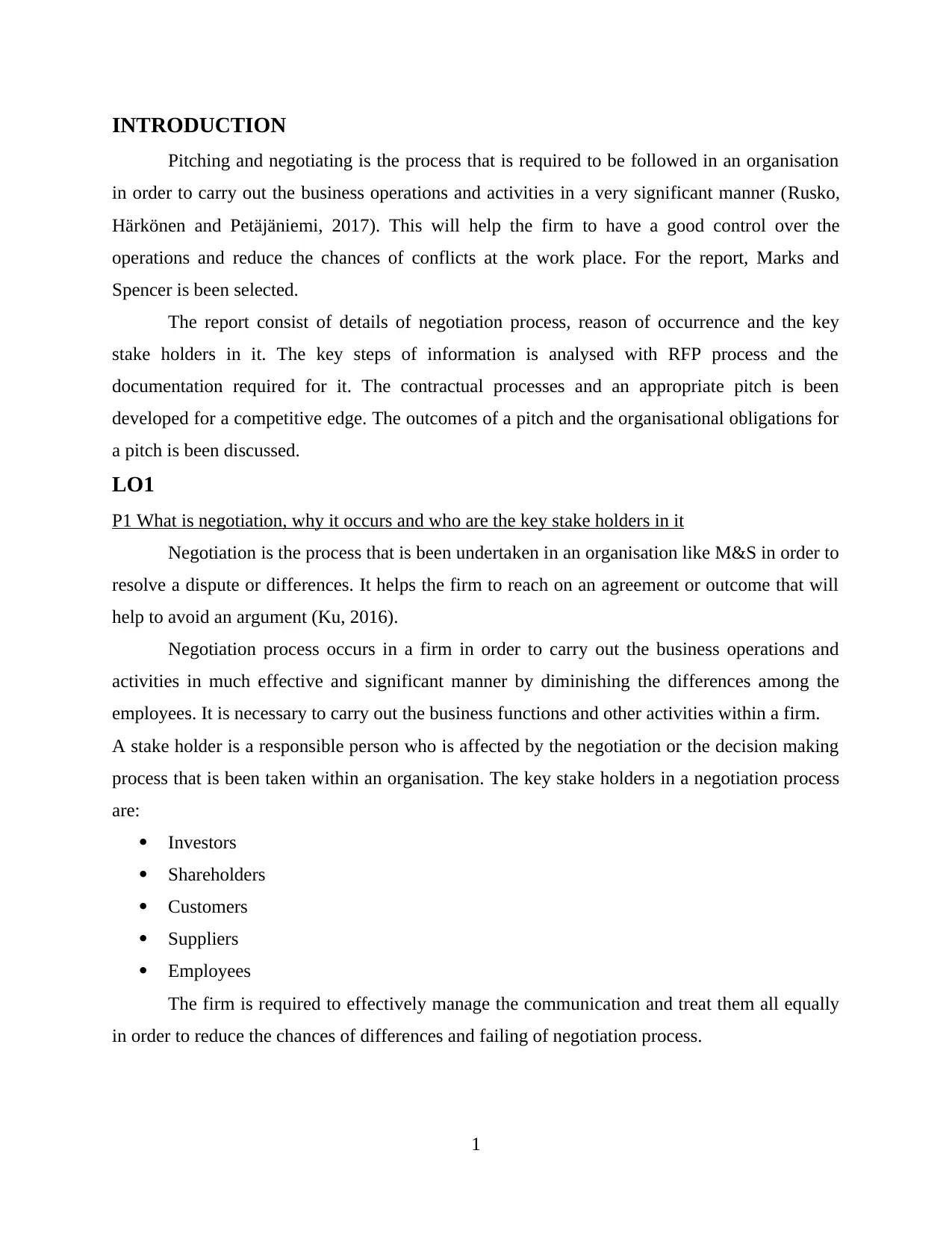
INTRODUCTION
Pitching and negotiating is the process that is required to be followed in an organisation
in order to carry out the business operations and activities in a very significant manner (Rusko,
Härkönen and Petäjäniemi, 2017). This will help the firm to have a good control over the
operations and reduce the chances of conflicts at the work place. For the report, Marks and
Spencer is been selected.
The report consist of details of negotiation process, reason of occurrence and the key
stake holders in it. The key steps of information is analysed with RFP process and the
documentation required for it. The contractual processes and an appropriate pitch is been
developed for a competitive edge. The outcomes of a pitch and the organisational obligations for
a pitch is been discussed.
LO1
P1 What is negotiation, why it occurs and who are the key stake holders in it
Negotiation is the process that is been undertaken in an organisation like M&S in order to
resolve a dispute or differences. It helps the firm to reach on an agreement or outcome that will
help to avoid an argument (Ku, 2016).
Negotiation process occurs in a firm in order to carry out the business operations and
activities in much effective and significant manner by diminishing the differences among the
employees. It is necessary to carry out the business functions and other activities within a firm.
A stake holder is a responsible person who is affected by the negotiation or the decision making
process that is been taken within an organisation. The key stake holders in a negotiation process
are:
Investors
Shareholders
Customers
Suppliers
Employees
The firm is required to effectively manage the communication and treat them all equally
in order to reduce the chances of differences and failing of negotiation process.
1
Pitching and negotiating is the process that is required to be followed in an organisation
in order to carry out the business operations and activities in a very significant manner (Rusko,
Härkönen and Petäjäniemi, 2017). This will help the firm to have a good control over the
operations and reduce the chances of conflicts at the work place. For the report, Marks and
Spencer is been selected.
The report consist of details of negotiation process, reason of occurrence and the key
stake holders in it. The key steps of information is analysed with RFP process and the
documentation required for it. The contractual processes and an appropriate pitch is been
developed for a competitive edge. The outcomes of a pitch and the organisational obligations for
a pitch is been discussed.
LO1
P1 What is negotiation, why it occurs and who are the key stake holders in it
Negotiation is the process that is been undertaken in an organisation like M&S in order to
resolve a dispute or differences. It helps the firm to reach on an agreement or outcome that will
help to avoid an argument (Ku, 2016).
Negotiation process occurs in a firm in order to carry out the business operations and
activities in much effective and significant manner by diminishing the differences among the
employees. It is necessary to carry out the business functions and other activities within a firm.
A stake holder is a responsible person who is affected by the negotiation or the decision making
process that is been taken within an organisation. The key stake holders in a negotiation process
are:
Investors
Shareholders
Customers
Suppliers
Employees
The firm is required to effectively manage the communication and treat them all equally
in order to reduce the chances of differences and failing of negotiation process.
1
⊘ This is a preview!⊘
Do you want full access?
Subscribe today to unlock all pages.

Trusted by 1+ million students worldwide
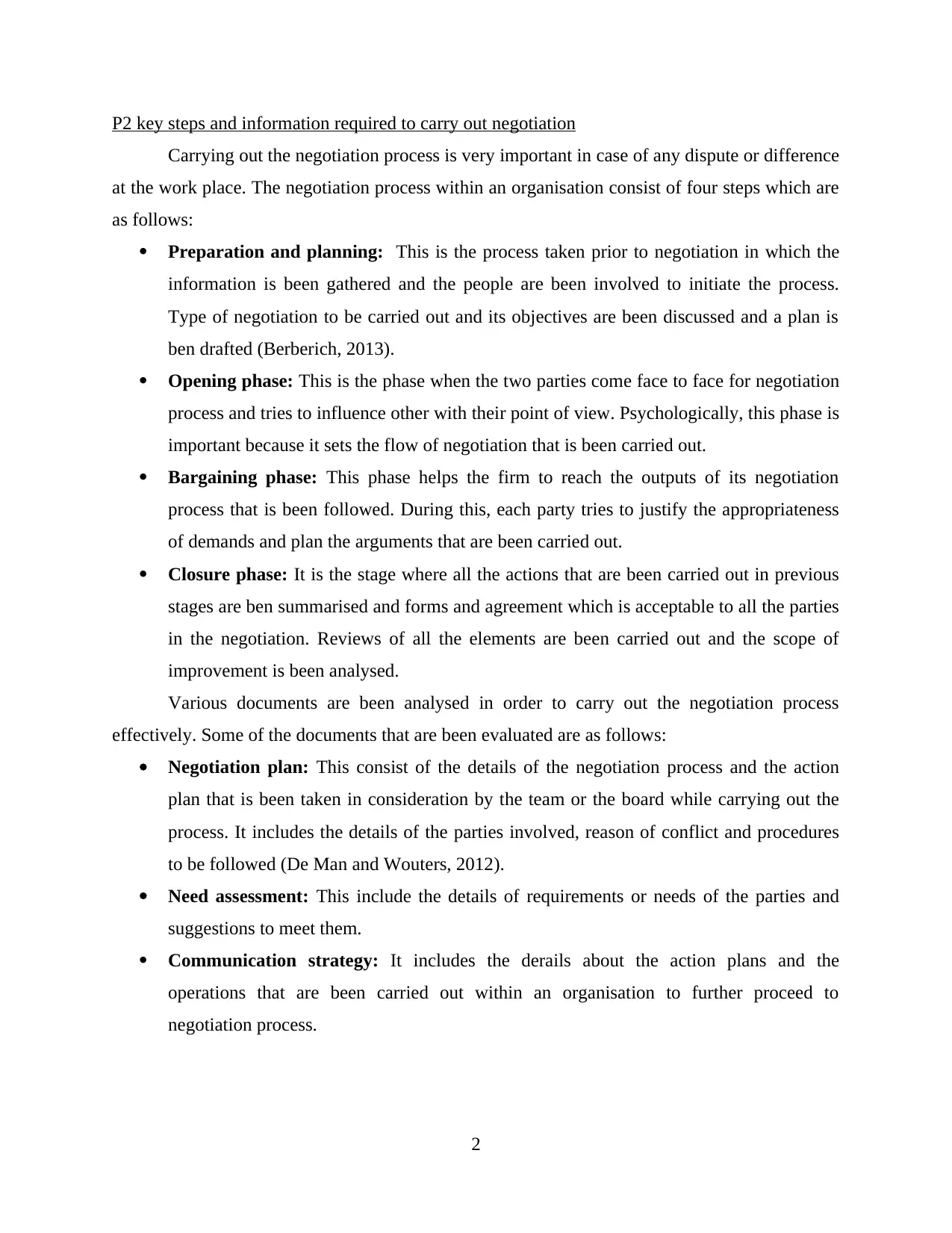
P2 key steps and information required to carry out negotiation
Carrying out the negotiation process is very important in case of any dispute or difference
at the work place. The negotiation process within an organisation consist of four steps which are
as follows:
Preparation and planning: This is the process taken prior to negotiation in which the
information is been gathered and the people are been involved to initiate the process.
Type of negotiation to be carried out and its objectives are been discussed and a plan is
ben drafted (Berberich, 2013).
Opening phase: This is the phase when the two parties come face to face for negotiation
process and tries to influence other with their point of view. Psychologically, this phase is
important because it sets the flow of negotiation that is been carried out.
Bargaining phase: This phase helps the firm to reach the outputs of its negotiation
process that is been followed. During this, each party tries to justify the appropriateness
of demands and plan the arguments that are been carried out.
Closure phase: It is the stage where all the actions that are been carried out in previous
stages are ben summarised and forms and agreement which is acceptable to all the parties
in the negotiation. Reviews of all the elements are been carried out and the scope of
improvement is been analysed.
Various documents are been analysed in order to carry out the negotiation process
effectively. Some of the documents that are been evaluated are as follows:
Negotiation plan: This consist of the details of the negotiation process and the action
plan that is been taken in consideration by the team or the board while carrying out the
process. It includes the details of the parties involved, reason of conflict and procedures
to be followed (De Man and Wouters, 2012).
Need assessment: This include the details of requirements or needs of the parties and
suggestions to meet them.
Communication strategy: It includes the derails about the action plans and the
operations that are been carried out within an organisation to further proceed to
negotiation process.
2
Carrying out the negotiation process is very important in case of any dispute or difference
at the work place. The negotiation process within an organisation consist of four steps which are
as follows:
Preparation and planning: This is the process taken prior to negotiation in which the
information is been gathered and the people are been involved to initiate the process.
Type of negotiation to be carried out and its objectives are been discussed and a plan is
ben drafted (Berberich, 2013).
Opening phase: This is the phase when the two parties come face to face for negotiation
process and tries to influence other with their point of view. Psychologically, this phase is
important because it sets the flow of negotiation that is been carried out.
Bargaining phase: This phase helps the firm to reach the outputs of its negotiation
process that is been followed. During this, each party tries to justify the appropriateness
of demands and plan the arguments that are been carried out.
Closure phase: It is the stage where all the actions that are been carried out in previous
stages are ben summarised and forms and agreement which is acceptable to all the parties
in the negotiation. Reviews of all the elements are been carried out and the scope of
improvement is been analysed.
Various documents are been analysed in order to carry out the negotiation process
effectively. Some of the documents that are been evaluated are as follows:
Negotiation plan: This consist of the details of the negotiation process and the action
plan that is been taken in consideration by the team or the board while carrying out the
process. It includes the details of the parties involved, reason of conflict and procedures
to be followed (De Man and Wouters, 2012).
Need assessment: This include the details of requirements or needs of the parties and
suggestions to meet them.
Communication strategy: It includes the derails about the action plans and the
operations that are been carried out within an organisation to further proceed to
negotiation process.
2
Paraphrase This Document
Need a fresh take? Get an instant paraphrase of this document with our AI Paraphraser
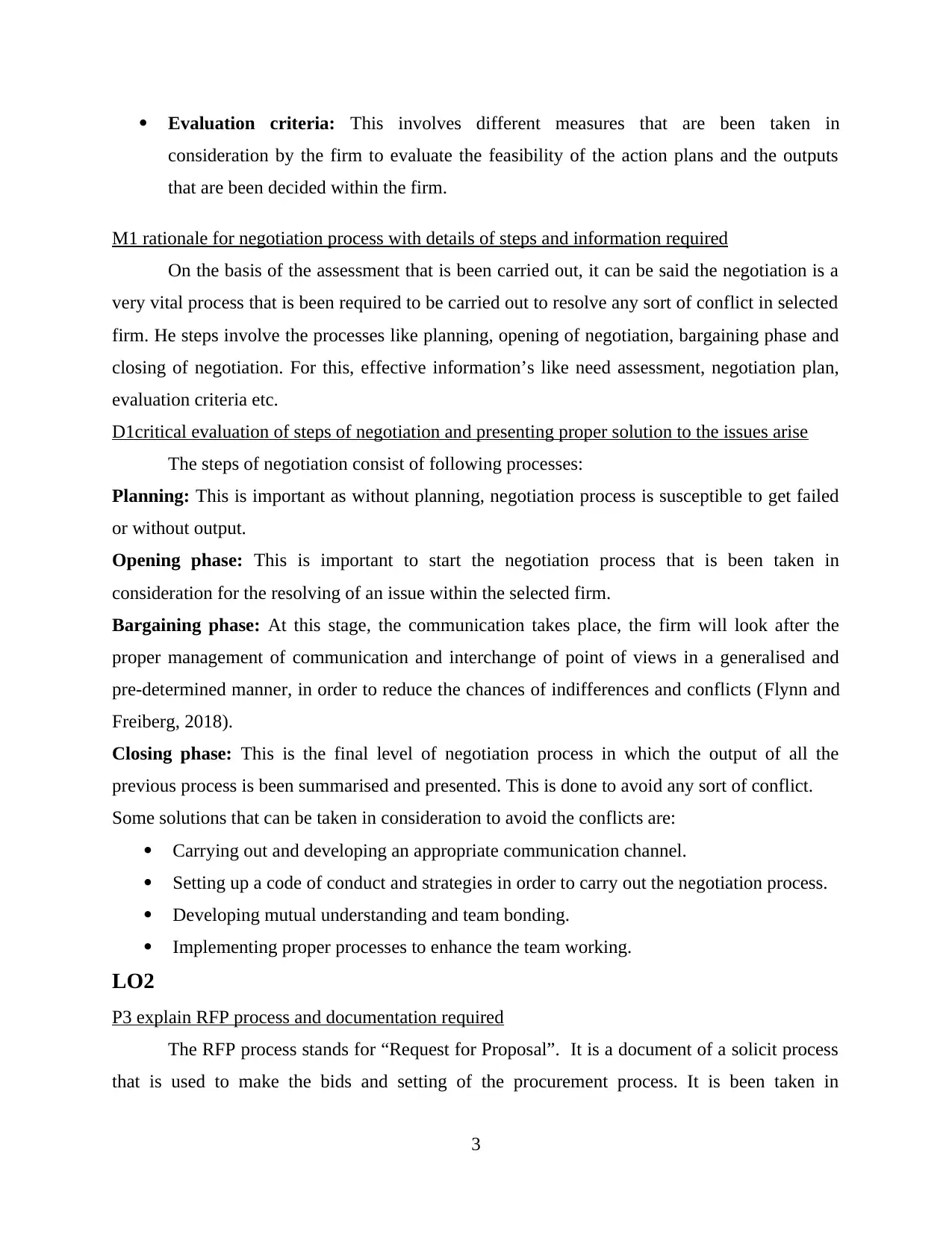
Evaluation criteria: This involves different measures that are been taken in
consideration by the firm to evaluate the feasibility of the action plans and the outputs
that are been decided within the firm.
M1 rationale for negotiation process with details of steps and information required
On the basis of the assessment that is been carried out, it can be said the negotiation is a
very vital process that is been required to be carried out to resolve any sort of conflict in selected
firm. He steps involve the processes like planning, opening of negotiation, bargaining phase and
closing of negotiation. For this, effective information’s like need assessment, negotiation plan,
evaluation criteria etc.
D1critical evaluation of steps of negotiation and presenting proper solution to the issues arise
The steps of negotiation consist of following processes:
Planning: This is important as without planning, negotiation process is susceptible to get failed
or without output.
Opening phase: This is important to start the negotiation process that is been taken in
consideration for the resolving of an issue within the selected firm.
Bargaining phase: At this stage, the communication takes place, the firm will look after the
proper management of communication and interchange of point of views in a generalised and
pre-determined manner, in order to reduce the chances of indifferences and conflicts (Flynn and
Freiberg, 2018).
Closing phase: This is the final level of negotiation process in which the output of all the
previous process is been summarised and presented. This is done to avoid any sort of conflict.
Some solutions that can be taken in consideration to avoid the conflicts are:
Carrying out and developing an appropriate communication channel.
Setting up a code of conduct and strategies in order to carry out the negotiation process.
Developing mutual understanding and team bonding.
Implementing proper processes to enhance the team working.
LO2
P3 explain RFP process and documentation required
The RFP process stands for “Request for Proposal”. It is a document of a solicit process
that is used to make the bids and setting of the procurement process. It is been taken in
3
consideration by the firm to evaluate the feasibility of the action plans and the outputs
that are been decided within the firm.
M1 rationale for negotiation process with details of steps and information required
On the basis of the assessment that is been carried out, it can be said the negotiation is a
very vital process that is been required to be carried out to resolve any sort of conflict in selected
firm. He steps involve the processes like planning, opening of negotiation, bargaining phase and
closing of negotiation. For this, effective information’s like need assessment, negotiation plan,
evaluation criteria etc.
D1critical evaluation of steps of negotiation and presenting proper solution to the issues arise
The steps of negotiation consist of following processes:
Planning: This is important as without planning, negotiation process is susceptible to get failed
or without output.
Opening phase: This is important to start the negotiation process that is been taken in
consideration for the resolving of an issue within the selected firm.
Bargaining phase: At this stage, the communication takes place, the firm will look after the
proper management of communication and interchange of point of views in a generalised and
pre-determined manner, in order to reduce the chances of indifferences and conflicts (Flynn and
Freiberg, 2018).
Closing phase: This is the final level of negotiation process in which the output of all the
previous process is been summarised and presented. This is done to avoid any sort of conflict.
Some solutions that can be taken in consideration to avoid the conflicts are:
Carrying out and developing an appropriate communication channel.
Setting up a code of conduct and strategies in order to carry out the negotiation process.
Developing mutual understanding and team bonding.
Implementing proper processes to enhance the team working.
LO2
P3 explain RFP process and documentation required
The RFP process stands for “Request for Proposal”. It is a document of a solicit process
that is used to make the bids and setting of the procurement process. It is been taken in
3
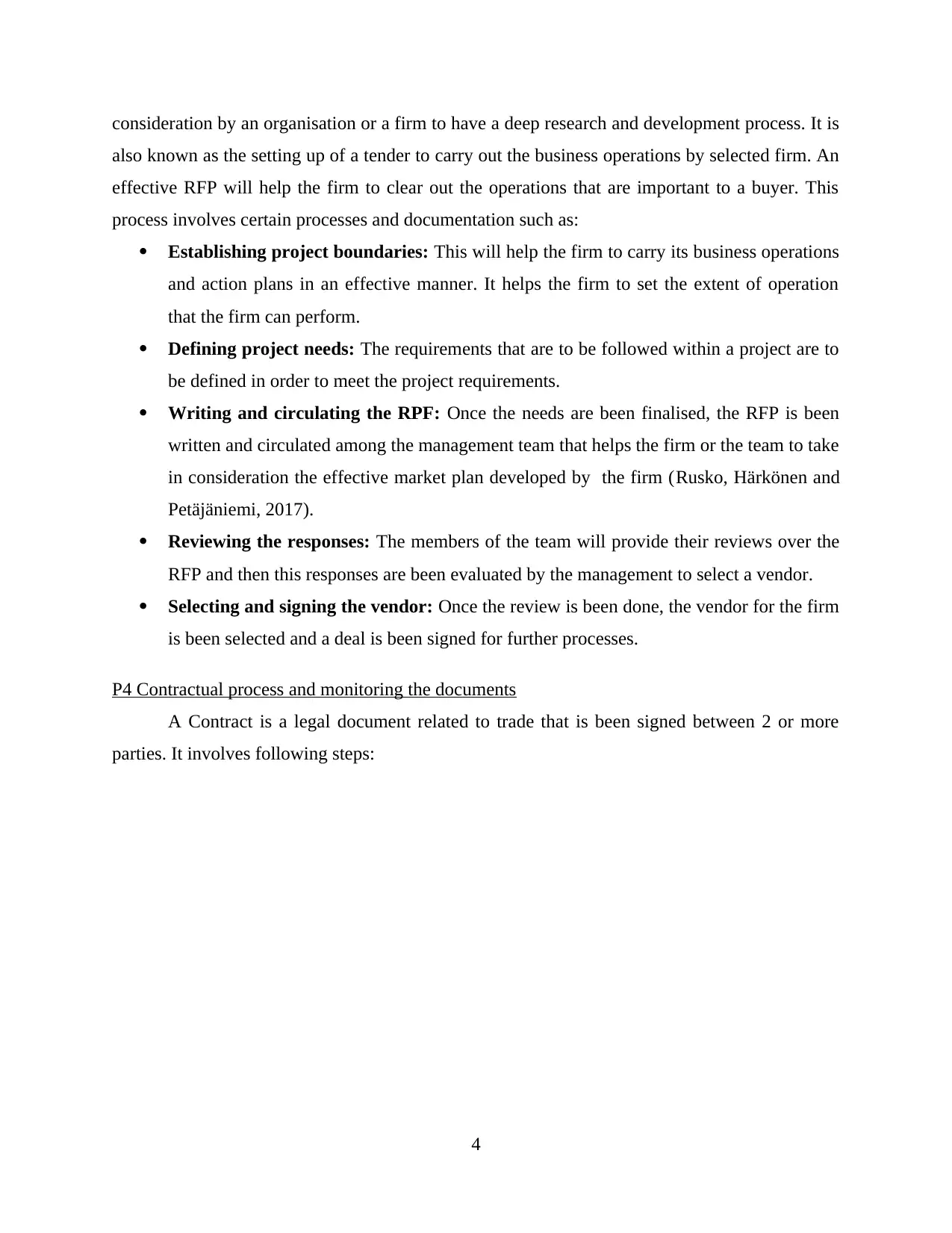
consideration by an organisation or a firm to have a deep research and development process. It is
also known as the setting up of a tender to carry out the business operations by selected firm. An
effective RFP will help the firm to clear out the operations that are important to a buyer. This
process involves certain processes and documentation such as:
Establishing project boundaries: This will help the firm to carry its business operations
and action plans in an effective manner. It helps the firm to set the extent of operation
that the firm can perform.
Defining project needs: The requirements that are to be followed within a project are to
be defined in order to meet the project requirements.
Writing and circulating the RPF: Once the needs are been finalised, the RFP is been
written and circulated among the management team that helps the firm or the team to take
in consideration the effective market plan developed by the firm (Rusko, Härkönen and
Petäjäniemi, 2017).
Reviewing the responses: The members of the team will provide their reviews over the
RFP and then this responses are been evaluated by the management to select a vendor.
Selecting and signing the vendor: Once the review is been done, the vendor for the firm
is been selected and a deal is been signed for further processes.
P4 Contractual process and monitoring the documents
A Contract is a legal document related to trade that is been signed between 2 or more
parties. It involves following steps:
4
also known as the setting up of a tender to carry out the business operations by selected firm. An
effective RFP will help the firm to clear out the operations that are important to a buyer. This
process involves certain processes and documentation such as:
Establishing project boundaries: This will help the firm to carry its business operations
and action plans in an effective manner. It helps the firm to set the extent of operation
that the firm can perform.
Defining project needs: The requirements that are to be followed within a project are to
be defined in order to meet the project requirements.
Writing and circulating the RPF: Once the needs are been finalised, the RFP is been
written and circulated among the management team that helps the firm or the team to take
in consideration the effective market plan developed by the firm (Rusko, Härkönen and
Petäjäniemi, 2017).
Reviewing the responses: The members of the team will provide their reviews over the
RFP and then this responses are been evaluated by the management to select a vendor.
Selecting and signing the vendor: Once the review is been done, the vendor for the firm
is been selected and a deal is been signed for further processes.
P4 Contractual process and monitoring the documents
A Contract is a legal document related to trade that is been signed between 2 or more
parties. It involves following steps:
4
⊘ This is a preview!⊘
Do you want full access?
Subscribe today to unlock all pages.

Trusted by 1+ million students worldwide
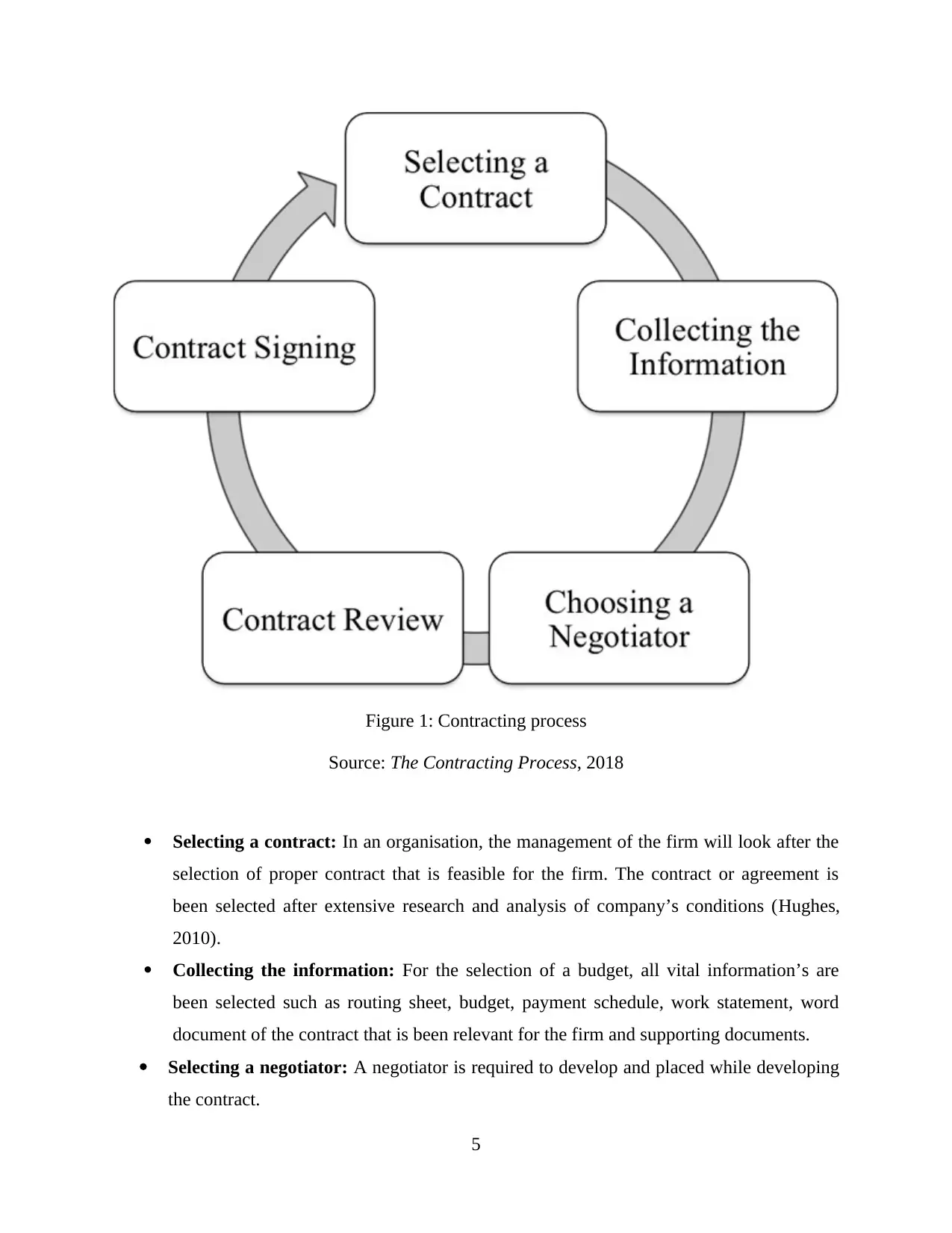
Figure 1: Contracting process
Source: The Contracting Process, 2018
Selecting a contract: In an organisation, the management of the firm will look after the
selection of proper contract that is feasible for the firm. The contract or agreement is
been selected after extensive research and analysis of company’s conditions (Hughes,
2010).
Collecting the information: For the selection of a budget, all vital information’s are
been selected such as routing sheet, budget, payment schedule, work statement, word
document of the contract that is been relevant for the firm and supporting documents.
Selecting a negotiator: A negotiator is required to develop and placed while developing
the contract.
5
Source: The Contracting Process, 2018
Selecting a contract: In an organisation, the management of the firm will look after the
selection of proper contract that is feasible for the firm. The contract or agreement is
been selected after extensive research and analysis of company’s conditions (Hughes,
2010).
Collecting the information: For the selection of a budget, all vital information’s are
been selected such as routing sheet, budget, payment schedule, work statement, word
document of the contract that is been relevant for the firm and supporting documents.
Selecting a negotiator: A negotiator is required to develop and placed while developing
the contract.
5
Paraphrase This Document
Need a fresh take? Get an instant paraphrase of this document with our AI Paraphraser
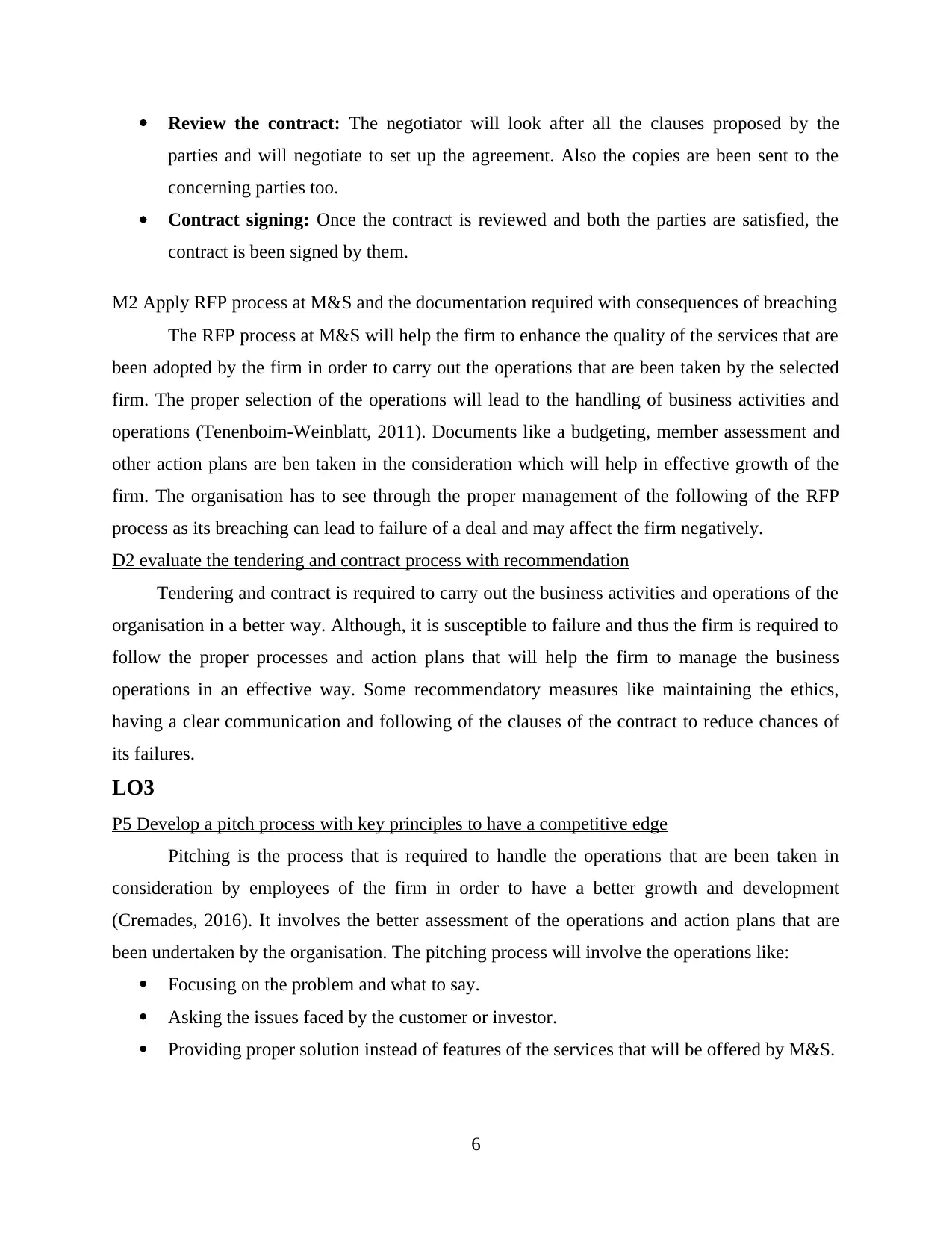
Review the contract: The negotiator will look after all the clauses proposed by the
parties and will negotiate to set up the agreement. Also the copies are been sent to the
concerning parties too.
Contract signing: Once the contract is reviewed and both the parties are satisfied, the
contract is been signed by them.
M2 Apply RFP process at M&S and the documentation required with consequences of breaching
The RFP process at M&S will help the firm to enhance the quality of the services that are
been adopted by the firm in order to carry out the operations that are been taken by the selected
firm. The proper selection of the operations will lead to the handling of business activities and
operations (Tenenboim-Weinblatt, 2011). Documents like a budgeting, member assessment and
other action plans are ben taken in the consideration which will help in effective growth of the
firm. The organisation has to see through the proper management of the following of the RFP
process as its breaching can lead to failure of a deal and may affect the firm negatively.
D2 evaluate the tendering and contract process with recommendation
Tendering and contract is required to carry out the business activities and operations of the
organisation in a better way. Although, it is susceptible to failure and thus the firm is required to
follow the proper processes and action plans that will help the firm to manage the business
operations in an effective way. Some recommendatory measures like maintaining the ethics,
having a clear communication and following of the clauses of the contract to reduce chances of
its failures.
LO3
P5 Develop a pitch process with key principles to have a competitive edge
Pitching is the process that is required to handle the operations that are been taken in
consideration by employees of the firm in order to have a better growth and development
(Cremades, 2016). It involves the better assessment of the operations and action plans that are
been undertaken by the organisation. The pitching process will involve the operations like:
Focusing on the problem and what to say.
Asking the issues faced by the customer or investor.
Providing proper solution instead of features of the services that will be offered by M&S.
6
parties and will negotiate to set up the agreement. Also the copies are been sent to the
concerning parties too.
Contract signing: Once the contract is reviewed and both the parties are satisfied, the
contract is been signed by them.
M2 Apply RFP process at M&S and the documentation required with consequences of breaching
The RFP process at M&S will help the firm to enhance the quality of the services that are
been adopted by the firm in order to carry out the operations that are been taken by the selected
firm. The proper selection of the operations will lead to the handling of business activities and
operations (Tenenboim-Weinblatt, 2011). Documents like a budgeting, member assessment and
other action plans are ben taken in the consideration which will help in effective growth of the
firm. The organisation has to see through the proper management of the following of the RFP
process as its breaching can lead to failure of a deal and may affect the firm negatively.
D2 evaluate the tendering and contract process with recommendation
Tendering and contract is required to carry out the business activities and operations of the
organisation in a better way. Although, it is susceptible to failure and thus the firm is required to
follow the proper processes and action plans that will help the firm to manage the business
operations in an effective way. Some recommendatory measures like maintaining the ethics,
having a clear communication and following of the clauses of the contract to reduce chances of
its failures.
LO3
P5 Develop a pitch process with key principles to have a competitive edge
Pitching is the process that is required to handle the operations that are been taken in
consideration by employees of the firm in order to have a better growth and development
(Cremades, 2016). It involves the better assessment of the operations and action plans that are
been undertaken by the organisation. The pitching process will involve the operations like:
Focusing on the problem and what to say.
Asking the issues faced by the customer or investor.
Providing proper solution instead of features of the services that will be offered by M&S.
6
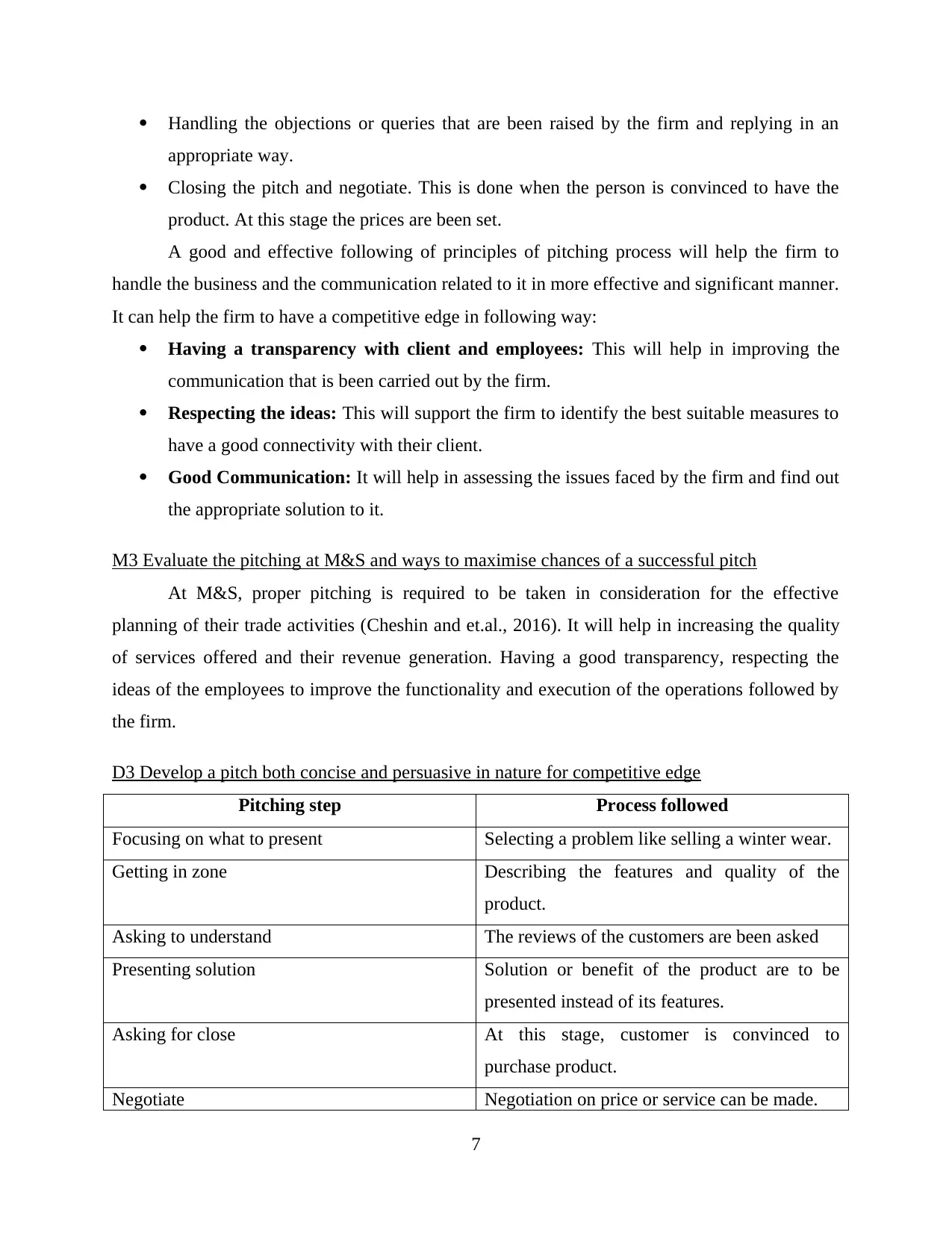
Handling the objections or queries that are been raised by the firm and replying in an
appropriate way.
Closing the pitch and negotiate. This is done when the person is convinced to have the
product. At this stage the prices are been set.
A good and effective following of principles of pitching process will help the firm to
handle the business and the communication related to it in more effective and significant manner.
It can help the firm to have a competitive edge in following way:
Having a transparency with client and employees: This will help in improving the
communication that is been carried out by the firm.
Respecting the ideas: This will support the firm to identify the best suitable measures to
have a good connectivity with their client.
Good Communication: It will help in assessing the issues faced by the firm and find out
the appropriate solution to it.
M3 Evaluate the pitching at M&S and ways to maximise chances of a successful pitch
At M&S, proper pitching is required to be taken in consideration for the effective
planning of their trade activities (Cheshin and et.al., 2016). It will help in increasing the quality
of services offered and their revenue generation. Having a good transparency, respecting the
ideas of the employees to improve the functionality and execution of the operations followed by
the firm.
D3 Develop a pitch both concise and persuasive in nature for competitive edge
Pitching step Process followed
Focusing on what to present Selecting a problem like selling a winter wear.
Getting in zone Describing the features and quality of the
product.
Asking to understand The reviews of the customers are been asked
Presenting solution Solution or benefit of the product are to be
presented instead of its features.
Asking for close At this stage, customer is convinced to
purchase product.
Negotiate Negotiation on price or service can be made.
7
appropriate way.
Closing the pitch and negotiate. This is done when the person is convinced to have the
product. At this stage the prices are been set.
A good and effective following of principles of pitching process will help the firm to
handle the business and the communication related to it in more effective and significant manner.
It can help the firm to have a competitive edge in following way:
Having a transparency with client and employees: This will help in improving the
communication that is been carried out by the firm.
Respecting the ideas: This will support the firm to identify the best suitable measures to
have a good connectivity with their client.
Good Communication: It will help in assessing the issues faced by the firm and find out
the appropriate solution to it.
M3 Evaluate the pitching at M&S and ways to maximise chances of a successful pitch
At M&S, proper pitching is required to be taken in consideration for the effective
planning of their trade activities (Cheshin and et.al., 2016). It will help in increasing the quality
of services offered and their revenue generation. Having a good transparency, respecting the
ideas of the employees to improve the functionality and execution of the operations followed by
the firm.
D3 Develop a pitch both concise and persuasive in nature for competitive edge
Pitching step Process followed
Focusing on what to present Selecting a problem like selling a winter wear.
Getting in zone Describing the features and quality of the
product.
Asking to understand The reviews of the customers are been asked
Presenting solution Solution or benefit of the product are to be
presented instead of its features.
Asking for close At this stage, customer is convinced to
purchase product.
Negotiate Negotiation on price or service can be made.
7
⊘ This is a preview!⊘
Do you want full access?
Subscribe today to unlock all pages.

Trusted by 1+ million students worldwide
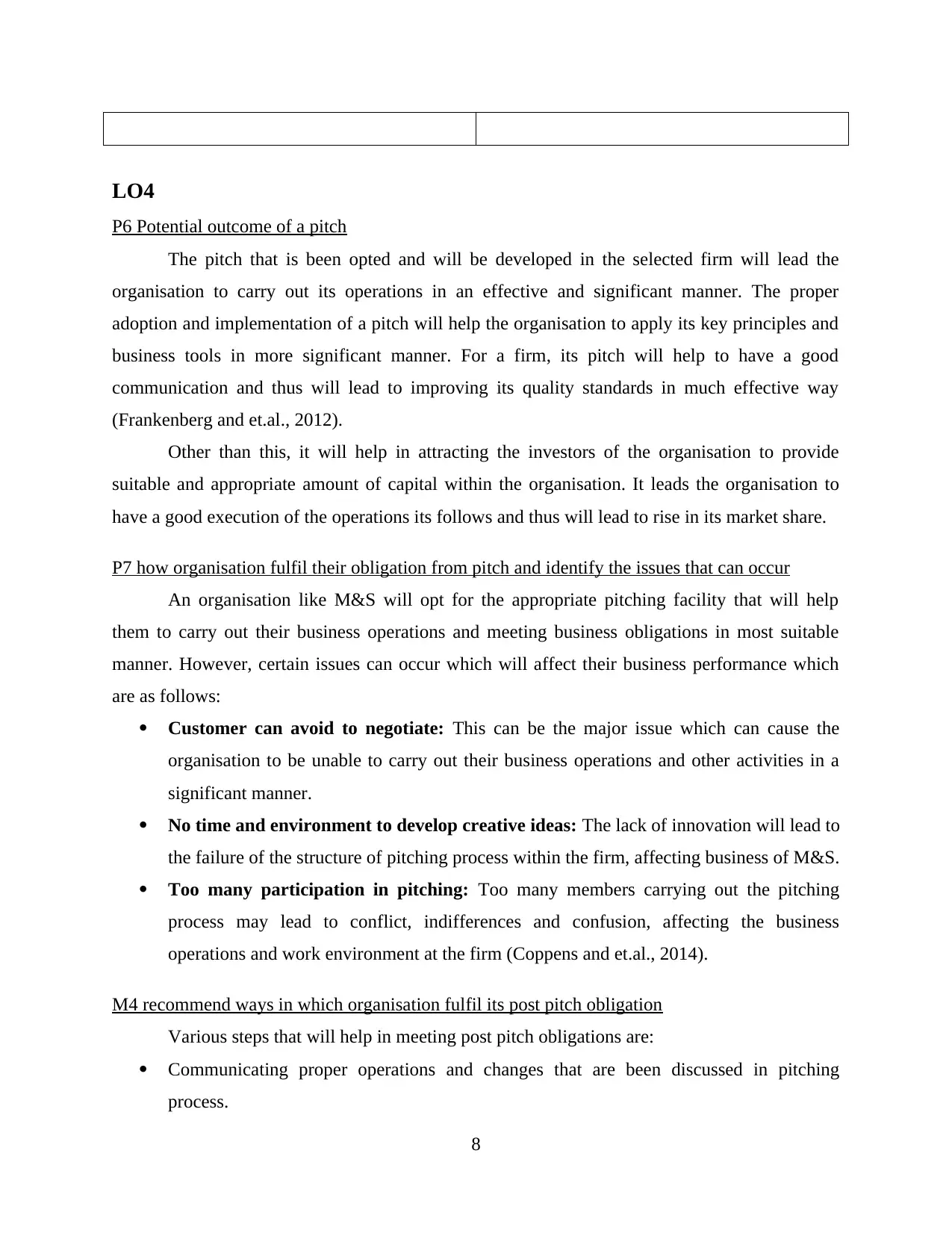
LO4
P6 Potential outcome of a pitch
The pitch that is been opted and will be developed in the selected firm will lead the
organisation to carry out its operations in an effective and significant manner. The proper
adoption and implementation of a pitch will help the organisation to apply its key principles and
business tools in more significant manner. For a firm, its pitch will help to have a good
communication and thus will lead to improving its quality standards in much effective way
(Frankenberg and et.al., 2012).
Other than this, it will help in attracting the investors of the organisation to provide
suitable and appropriate amount of capital within the organisation. It leads the organisation to
have a good execution of the operations its follows and thus will lead to rise in its market share.
P7 how organisation fulfil their obligation from pitch and identify the issues that can occur
An organisation like M&S will opt for the appropriate pitching facility that will help
them to carry out their business operations and meeting business obligations in most suitable
manner. However, certain issues can occur which will affect their business performance which
are as follows:
Customer can avoid to negotiate: This can be the major issue which can cause the
organisation to be unable to carry out their business operations and other activities in a
significant manner.
No time and environment to develop creative ideas: The lack of innovation will lead to
the failure of the structure of pitching process within the firm, affecting business of M&S.
Too many participation in pitching: Too many members carrying out the pitching
process may lead to conflict, indifferences and confusion, affecting the business
operations and work environment at the firm (Coppens and et.al., 2014).
M4 recommend ways in which organisation fulfil its post pitch obligation
Various steps that will help in meeting post pitch obligations are:
Communicating proper operations and changes that are been discussed in pitching
process.
8
P6 Potential outcome of a pitch
The pitch that is been opted and will be developed in the selected firm will lead the
organisation to carry out its operations in an effective and significant manner. The proper
adoption and implementation of a pitch will help the organisation to apply its key principles and
business tools in more significant manner. For a firm, its pitch will help to have a good
communication and thus will lead to improving its quality standards in much effective way
(Frankenberg and et.al., 2012).
Other than this, it will help in attracting the investors of the organisation to provide
suitable and appropriate amount of capital within the organisation. It leads the organisation to
have a good execution of the operations its follows and thus will lead to rise in its market share.
P7 how organisation fulfil their obligation from pitch and identify the issues that can occur
An organisation like M&S will opt for the appropriate pitching facility that will help
them to carry out their business operations and meeting business obligations in most suitable
manner. However, certain issues can occur which will affect their business performance which
are as follows:
Customer can avoid to negotiate: This can be the major issue which can cause the
organisation to be unable to carry out their business operations and other activities in a
significant manner.
No time and environment to develop creative ideas: The lack of innovation will lead to
the failure of the structure of pitching process within the firm, affecting business of M&S.
Too many participation in pitching: Too many members carrying out the pitching
process may lead to conflict, indifferences and confusion, affecting the business
operations and work environment at the firm (Coppens and et.al., 2014).
M4 recommend ways in which organisation fulfil its post pitch obligation
Various steps that will help in meeting post pitch obligations are:
Communicating proper operations and changes that are been discussed in pitching
process.
8
Paraphrase This Document
Need a fresh take? Get an instant paraphrase of this document with our AI Paraphraser
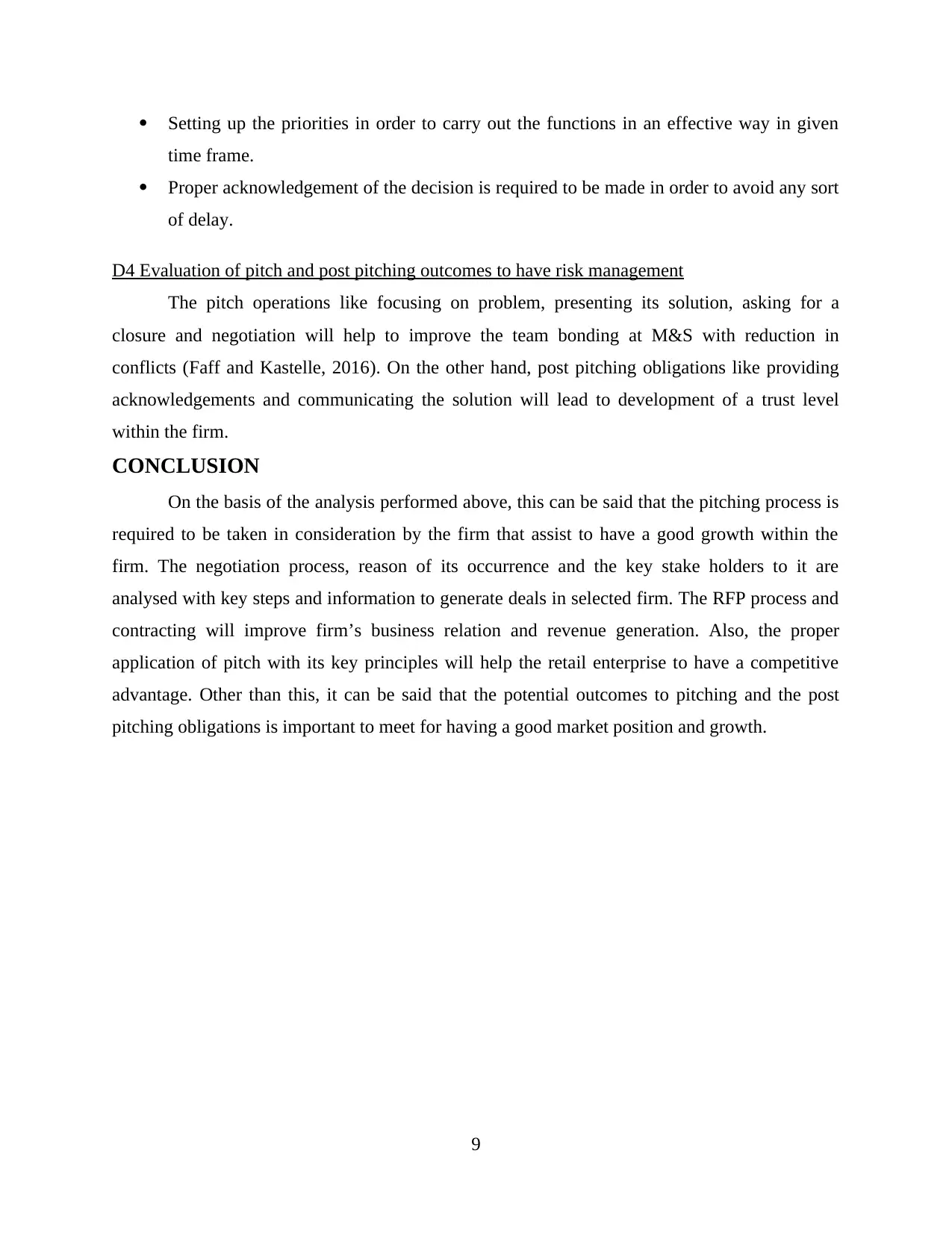
Setting up the priorities in order to carry out the functions in an effective way in given
time frame.
Proper acknowledgement of the decision is required to be made in order to avoid any sort
of delay.
D4 Evaluation of pitch and post pitching outcomes to have risk management
The pitch operations like focusing on problem, presenting its solution, asking for a
closure and negotiation will help to improve the team bonding at M&S with reduction in
conflicts (Faff and Kastelle, 2016). On the other hand, post pitching obligations like providing
acknowledgements and communicating the solution will lead to development of a trust level
within the firm.
CONCLUSION
On the basis of the analysis performed above, this can be said that the pitching process is
required to be taken in consideration by the firm that assist to have a good growth within the
firm. The negotiation process, reason of its occurrence and the key stake holders to it are
analysed with key steps and information to generate deals in selected firm. The RFP process and
contracting will improve firm’s business relation and revenue generation. Also, the proper
application of pitch with its key principles will help the retail enterprise to have a competitive
advantage. Other than this, it can be said that the potential outcomes to pitching and the post
pitching obligations is important to meet for having a good market position and growth.
9
time frame.
Proper acknowledgement of the decision is required to be made in order to avoid any sort
of delay.
D4 Evaluation of pitch and post pitching outcomes to have risk management
The pitch operations like focusing on problem, presenting its solution, asking for a
closure and negotiation will help to improve the team bonding at M&S with reduction in
conflicts (Faff and Kastelle, 2016). On the other hand, post pitching obligations like providing
acknowledgements and communicating the solution will lead to development of a trust level
within the firm.
CONCLUSION
On the basis of the analysis performed above, this can be said that the pitching process is
required to be taken in consideration by the firm that assist to have a good growth within the
firm. The negotiation process, reason of its occurrence and the key stake holders to it are
analysed with key steps and information to generate deals in selected firm. The RFP process and
contracting will improve firm’s business relation and revenue generation. Also, the proper
application of pitch with its key principles will help the retail enterprise to have a competitive
advantage. Other than this, it can be said that the potential outcomes to pitching and the post
pitching obligations is important to meet for having a good market position and growth.
9
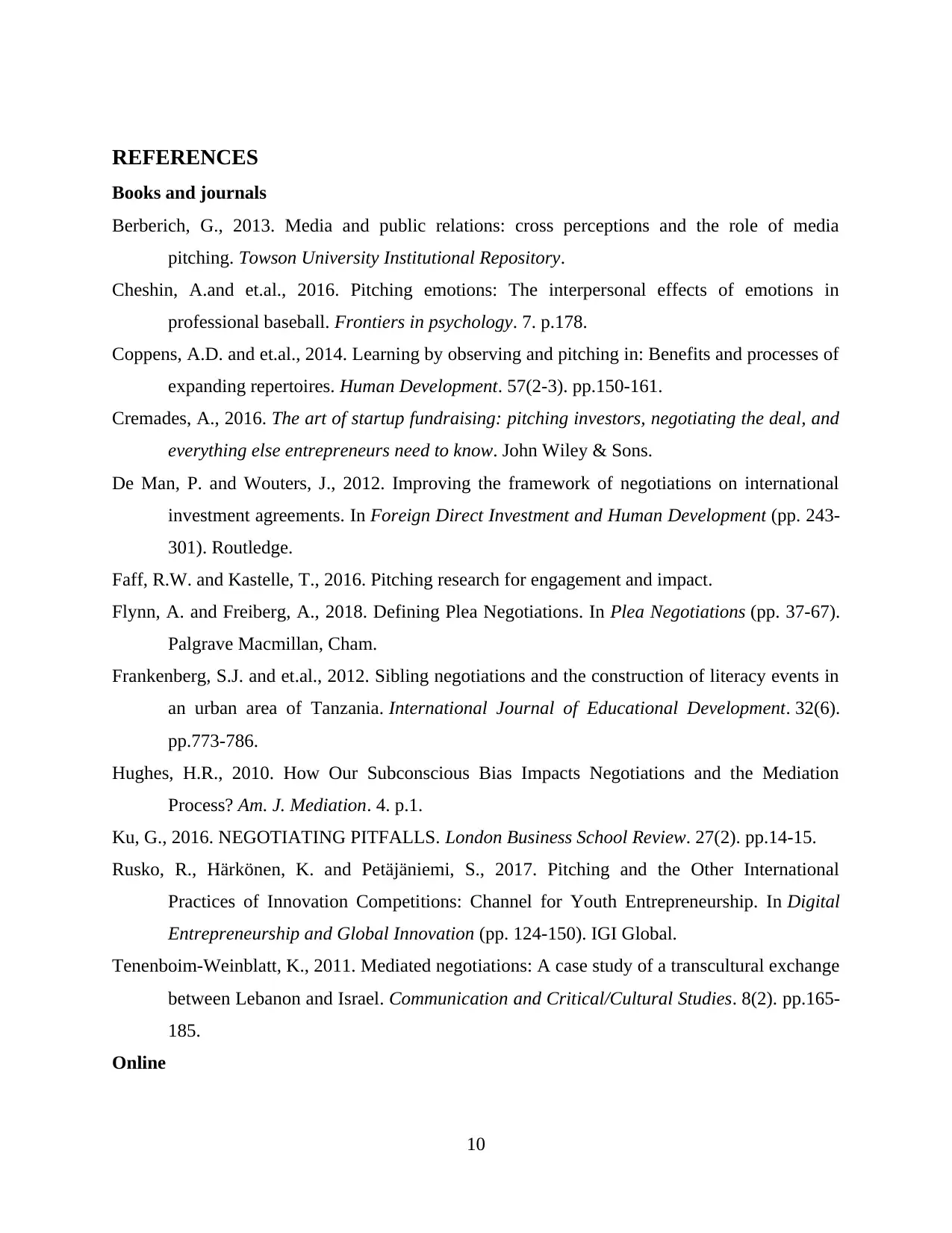
REFERENCES
Books and journals
Berberich, G., 2013. Media and public relations: cross perceptions and the role of media
pitching. Towson University Institutional Repository.
Cheshin, A.and et.al., 2016. Pitching emotions: The interpersonal effects of emotions in
professional baseball. Frontiers in psychology. 7. p.178.
Coppens, A.D. and et.al., 2014. Learning by observing and pitching in: Benefits and processes of
expanding repertoires. Human Development. 57(2-3). pp.150-161.
Cremades, A., 2016. The art of startup fundraising: pitching investors, negotiating the deal, and
everything else entrepreneurs need to know. John Wiley & Sons.
De Man, P. and Wouters, J., 2012. Improving the framework of negotiations on international
investment agreements. In Foreign Direct Investment and Human Development (pp. 243-
301). Routledge.
Faff, R.W. and Kastelle, T., 2016. Pitching research for engagement and impact.
Flynn, A. and Freiberg, A., 2018. Defining Plea Negotiations. In Plea Negotiations (pp. 37-67).
Palgrave Macmillan, Cham.
Frankenberg, S.J. and et.al., 2012. Sibling negotiations and the construction of literacy events in
an urban area of Tanzania. International Journal of Educational Development. 32(6).
pp.773-786.
Hughes, H.R., 2010. How Our Subconscious Bias Impacts Negotiations and the Mediation
Process? Am. J. Mediation. 4. p.1.
Ku, G., 2016. NEGOTIATING PITFALLS. London Business School Review. 27(2). pp.14-15.
Rusko, R., Härkönen, K. and Petäjäniemi, S., 2017. Pitching and the Other International
Practices of Innovation Competitions: Channel for Youth Entrepreneurship. In Digital
Entrepreneurship and Global Innovation (pp. 124-150). IGI Global.
Tenenboim-Weinblatt, K., 2011. Mediated negotiations: A case study of a transcultural exchange
between Lebanon and Israel. Communication and Critical/Cultural Studies. 8(2). pp.165-
185.
Online
10
Books and journals
Berberich, G., 2013. Media and public relations: cross perceptions and the role of media
pitching. Towson University Institutional Repository.
Cheshin, A.and et.al., 2016. Pitching emotions: The interpersonal effects of emotions in
professional baseball. Frontiers in psychology. 7. p.178.
Coppens, A.D. and et.al., 2014. Learning by observing and pitching in: Benefits and processes of
expanding repertoires. Human Development. 57(2-3). pp.150-161.
Cremades, A., 2016. The art of startup fundraising: pitching investors, negotiating the deal, and
everything else entrepreneurs need to know. John Wiley & Sons.
De Man, P. and Wouters, J., 2012. Improving the framework of negotiations on international
investment agreements. In Foreign Direct Investment and Human Development (pp. 243-
301). Routledge.
Faff, R.W. and Kastelle, T., 2016. Pitching research for engagement and impact.
Flynn, A. and Freiberg, A., 2018. Defining Plea Negotiations. In Plea Negotiations (pp. 37-67).
Palgrave Macmillan, Cham.
Frankenberg, S.J. and et.al., 2012. Sibling negotiations and the construction of literacy events in
an urban area of Tanzania. International Journal of Educational Development. 32(6).
pp.773-786.
Hughes, H.R., 2010. How Our Subconscious Bias Impacts Negotiations and the Mediation
Process? Am. J. Mediation. 4. p.1.
Ku, G., 2016. NEGOTIATING PITFALLS. London Business School Review. 27(2). pp.14-15.
Rusko, R., Härkönen, K. and Petäjäniemi, S., 2017. Pitching and the Other International
Practices of Innovation Competitions: Channel for Youth Entrepreneurship. In Digital
Entrepreneurship and Global Innovation (pp. 124-150). IGI Global.
Tenenboim-Weinblatt, K., 2011. Mediated negotiations: A case study of a transcultural exchange
between Lebanon and Israel. Communication and Critical/Cultural Studies. 8(2). pp.165-
185.
Online
10
⊘ This is a preview!⊘
Do you want full access?
Subscribe today to unlock all pages.

Trusted by 1+ million students worldwide
1 out of 13
Related Documents
Your All-in-One AI-Powered Toolkit for Academic Success.
+13062052269
info@desklib.com
Available 24*7 on WhatsApp / Email
![[object Object]](/_next/static/media/star-bottom.7253800d.svg)
Unlock your academic potential
Copyright © 2020–2025 A2Z Services. All Rights Reserved. Developed and managed by ZUCOL.





